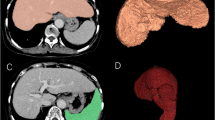Abstract
Background/purpose
We developed software to calculate the pixels of interest in the area between the hepatic and heart curves (ABC) of 99mTc-galactosyl human serum albumin (GSA) scintigraphy. The aim of this study was to examine the accuracy of the ABC to evaluate liver function before hepatectomy.
Methods
Between January 2005 and December 2010, 205 consecutive patients who underwent initial hepatectomy were enrolled in this study. The ABC was calculated using original computer software. The area under the receiver operating characteristic curve (AUC) was calculated for evaluation of Child–Pugh score grade B (Child B), pathological chronic hepatitis (CH), and liver cirrhosis (LC).
Results
The AUC of any indicator for Child B was more than 0.900 except bilirubin. The AUC of ABC for CH and LC (AUC 0.734 each) was comparable to those of HH15 (clearance index; AUC 0.704 and 0.700, respectively) and LHL15 (receptor index; AUC 0.703 and 0.706, respectively) in multiple receiver operating characteristic comparison.
Conclusions
We have developed a novel liver function indicator, the ABC, to count radioactivity in sequence. The ABC reflects liver function according to pathological deterioration of the liver. Although the ABC gave no significant advantage compared to HH15 and LHL15, it improved the AUC evaluation by 0.028–0.034.





Similar content being viewed by others
References
El-Serag HB, Mason AC. Rising incidence of hepatocellular carcinoma in the United States. N Engl J Med. 1999;340:745–50.
Llovet JM, Bru C, Bruix J. Prognosis of hepatocellular carcinoma: the BCLC staging classification. Semin Liver Dis. 1999;19:329–38.
Schutte K, Bornschein J, Malfertheiner P. Hepatocellular carcinoma—epidemiological trends and risk factors. Dig Dis. 2009;27:80–92.
Belghiti J, Kianmanesh R. Surgical treatment of hepatocellular carcinoma. HPB (Oxford). 2005;7:42–9.
Yi NJ, Suh KS, Kim T, Kim J, Shin WY, Lee KU. Current role of surgery in treatment of early stage hepatocellular carcinoma: resection versus liver transplantation. Oncology. 2008;75(Suppl 1):124–8.
Schneider PD. Preoperative assessment of liver function. Surg Clin North Am. 2004;84:355–73.
Sakka SG. Assessing liver function. Curr Opin Crit Care. 2007;13:207–14.
Manizate F, Hiotis SP, Labow D, Roayaie S, Schwartz M. Liver functional reserve estimation: state of the art and relevance for local treatments: the Western perspective. J Hepatobiliary Pancreat Sci. 2010;17:385–8.
Mizuguchi T, Nagayama M, Meguro M, Shibata T, Kaji S, Nobuoka T, et al. Prognostic impact of surgical complications and preoperative serum hepatocyte growth factor in hepatocellular carcinoma patients after initial hepatectomy. J Gastrointest Surg. 2009;13:325–33.
Mizuguchi T, Katsuramaki T, Nobuoka T, Kawamoto M, Oshima H, Kawasaki H, et al. Serum hyaluronate level for predicting subclinical liver dysfunction after hepatectomy. World J Surg. 2004;28:971–6.
Imamura H, Sano K, Sugawara Y, Kokudo N, Makuuchi M. Assessment of hepatic reserve for indication of hepatic resection: decision tree incorporating indocyanine green test. J Hepatobiliary Pancreat Surg. 2005;12:16–22.
Kubo S, Shiomi S, Tanaka H, Shuto T, Takemura S, Mikami S, et al. Evaluation of the effect of portal vein embolization on liver function by 99mTc-galactosyl human serum albumin scintigraphy. J Surg Res. 2002;107:113–8.
Kokudo N, Vera DR, Makuuchi M. Clinical application of TcGSA. Nucl Med Biol. 2003;30:845–9.
Iimuro Y, Kashiwagi T, Yamanaka J, Hirano T, Saito S, Sugimoto T, et al. Preoperative estimation of asialoglycoprotein receptor expression in the remnant liver from CT/99mTc-GSA SPECT fusion images correlates well with postoperative liver function parameters. J Hepatobiliary Pancreat Sci. 2010;17:673–81.
Koizumi K, Uchiyama G, Arai T, Ainoda T, Yoda Y. A new liver functional study using Tc-99m DTPA-galactosyl human serum albumin: evaluation of the validity of several functional parameters. Ann Nucl Med. 1992;6:83–7.
de Graaf W, Bennink RJ, Vetelainen R, van Gulik TM. Nuclear imaging techniques for the assessment of hepatic function in liver surgery and transplantation. J Nucl Med. 2010;51:742–52.
Vera DR, Stadalnik RC, Trudeau WL, Scheibe PO, Krohn KA. Measurement of receptor concentration and forward-binding rate constant via radiopharmacokinetic modeling of technetium-99m-galactosyl-neoglycoalbumin. J Nucl Med. 1991;32:1169–76.
Ha-Kawa SK, Tanaka Y. A quantitative model of technetium-99m-DTPA-galactosyl-HSA for the assessment of hepatic blood flow and hepatic binding receptor. J Nucl Med. 1991;32:2233–40.
Miki K, Kubota K, Kokudo N, Inoue Y, Bandai Y, Makuuchi M. Asialoglycoprotein receptor and hepatic blood flow using technetium-99m-DTPA-galactosyl human serum albumin. J Nucl Med. 1997;38:1798–807.
Kokudo N, Vera DR, Tada K, Koizumi M, Seki M, Matsubara T, et al. Predictors of successful hepatic resection: prognostic usefulness of hepatic asialoglycoprotein receptor analysis. World J Surg. 2002;26:1342–7.
Kwon AH, Matsui Y, Ha-Kawa SK, Kamiyama Y. Functional hepatic volume measured by technetium-99m-galactosyl-human serum albumin liver scintigraphy: comparison between hepatocyte volume and liver volume by computed tomography. Am J Gastroenterol. 2001;96:541–6.
Acknowledgments
We thank Kim Barrymore for his help in preparing this manuscript. A part of this study was supported by Grant-in-Aid for Scientific Research from The Ministry of Education, Culture, Sports, Science and Technology No. 23591993 to T. Mizuguchi.
Author information
Authors and Affiliations
Corresponding author
About this article
Cite this article
Harada, K., Mizuguchi, T., Katagiri, Y. et al. Area between the hepatic and heart curves of 99mTc-galactosyl-human serum albumin scintigraphy represents liver function and disease progression for preoperative evaluation in hepatocellular carcinoma patients. J Hepatobiliary Pancreat Sci 19, 667–673 (2012). https://doi.org/10.1007/s00534-011-0486-2
Published:
Issue Date:
DOI: https://doi.org/10.1007/s00534-011-0486-2




